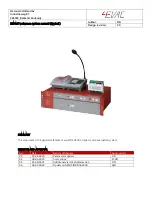
84
The BFS provides the most clinically useful qualitative maps and is recommended for refractive
screening, as conditions such as astigmatism and ectatic change are easily identified with it.
While the BFS is the most clinically useful reference shape, it is important to realize that the normal
cornea is aspherical and the BFS will vary depending on how much of the cornea is used to compute
it. Since the normal cornea is steeper centrally and flatter in the periphery, the BFS will increase in
radius of curvature (flatten) as the corneal area used for its computation is enlargened. Changing
the reference surface will change the qualitative appearance of the maps. A larger area will cause
the reference surface to be flatter and will accentuate the normal asphericity of the cornea, while
a smaller area will cause the reference surface to be steeper and will mask the normal asphericity
(Figure 103)
.
The problem with raw elevation data is that it lacks sufficient surface variation for the observer to
easily separate normal eyes from abnormal. In order to make elevation qualitatively useful, we need
to display the data in a more clinically relevant manner. To do this we typically display the elevation
data against a non-planar reference surface. It needs to be understood that the reference surface,
while affecting the qualitative appearance of the maps, does nothing to alter the quantitative
accuracy. The reference surface alters the appearance, but not the accuracy, sensitivity or specificity
(for the computer). The reference surface is chosen to allow us to make a clinically useful and rapid
visual inspection.
The most commonly used reference surface is a best-fit sphere (BFS). Other surfaces can be chosen
(e.g. best fit ellipse (BFE), best fit toric ellipse (BFTE), best fit toric ellipse fixed (BFTEF)), and while
some of these surfaces may have some utility, they lack the intuitive ease of visual inspection of a
BFS.
Figure 102
, depicts an early cone using a BFS (upper left), a BFE (upper right), a BFTEF (lower
left) and a BFTE (lower right). The cone is easily identified as a positive island of elevation using the
BFS, but is almost completely masked by the BFE and BFTE and, to a lesser degree, in the BFTEF.
Figure 102: Eelevation maps based on different reference surfaces: BFS, BFE, BFTE, BFTEF
12 Belin/Ambrósio Enhanced Ectasia Display
Содержание Pentacam
Страница 45: ...43 Figure 51 General Overview display showing a low ACV shallow ACD and narrow angle in OS 9 Glaucoma...
Страница 75: ...73 Figure 86 Show 2 Exams Pachymetric showing a case of Fuchs dystrophy 11 Corneal Thickness...
Страница 214: ...212 The following pages remain free and offer space for personal notes...
















































